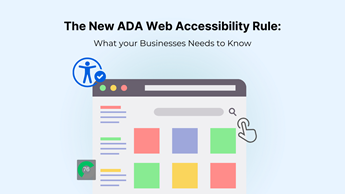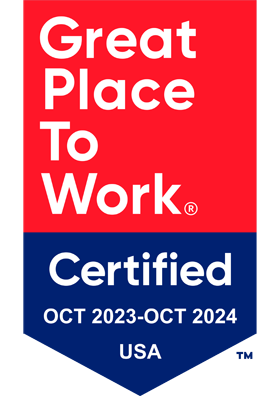Blogs
Is your website easy for everyone to use?
Do you know if your website is truly accessible? Or are you turning away customers? Many businesses and organizations focus on creating visually appealing, high-performing websites. But without proper accessibility measures in place, a large number of users with disabilities may struggle to navigate them. As digital experiences become necessary in daily life, ensuring inclusivity is not just about compliance—it’s about providing equal access and creating a better user experience for all.
With the latest Americans with Disabilities Act (ADA) Web and Mobile Accessibility Rule finalized in April 2024, accessibility is no longer an afterthought. The U.S. Department of Justice (DOJ) now requires state and local government websites and mobile apps to meet Web Content Accessibility Guidelines (WCAG) 2.1 Level AA by 2026 or 2027, depending on the organization’s size. While this rule specifically applies to public organizations, its impact could reach far beyond government entities.
The ADA has required that businesses provide equal access to services, including digital experiences. However, there was no specific federal rule enforcing web and mobile accessibility until until April 2024.
Under the new rule, state and local governments must ensure that their websites and mobile apps comply with WCAG 2.1 Level AA standards by the following deadlines:
April 2026 for larger entities (populations of 50,000+).
April 2027 for smaller entities (populations under 50,000).
While private businesses are not explicitly included in this rule, the DOJ and several US federal courts have consistently referenced WCAG as the standard for digital accessibility compliance. This means that businesses operating public-facing websites—especially those providing essential services—should align with these guidelines to minimize legal risks and enhance usability for all users.
Why Web Accessibility Matters
Many people assume accessibility is only for those with visible disabilities, but the reality is different. Disabilities come in many forms—permanent, temporary, situational, dynamic, and invisible. Someone with a permanent disability may use assistive technology daily, while a person with a temporary injury or a situational impairment (like being in a noisy environment) may also struggle to access digital content.
Accessibility is not only about following the law. It helps businesses reach more people, improve user experience, and reduce legal risks.
Reach More Customers
About one in four adults in the U.S. has a disability. If your website is not accessible, you could be excluding millions of potential users—and customers.
Improve User Experience
Accessible websites are easier to use for everyone. Features like clear navigation, good contrast, and simple and responsive design help support all users, including older adults and mobile users.
Reduce Legal Risks
More businesses are facing accessibility lawsuits. Addressing accessibility problems early and proactively can prevent legal issues and protect your brand.
Boost SEO and Website Performance
Many WCAG guidelines also help with SEO. Proper heading structures, alt text, and clear navigation improve search rankings and site performance.
Tools and Suggestions for Businesses
Businesses that prioritize accessibility can benefit in many ways, from improved user experience to better SEO and legal compliance. Making your website and digital products accessible might seem daunting, but with the right tools and approach, it’s absolutely doable. Here’s how to get started:
1. Conduct an Accessibility Audit
The best way to start improving accessibility is to identify existing barriers on your website or app. Automated testing tools can scan for common issues, while real- user testing ensures a better experience for people with disabilities.
Tools to use:
- WAVE: Detects accessibility errors, like missing alt text or contrast issues.
- Siteimprove: A powerful tool that provides detailed accessibility reports, broken links, SEO insights, and compliance tracking for ongoing website improvements.
- Google Lighthouse: Provides insights on accessibility, performance, and best practices.
- AccessiBe: An AI-powered accessibility tool that helps websites automatically adjust to WCAG standards. It offers screen-reader adjustments, keyboard navigation enhancements, and contrast controls.
2. Implement WCAG 2.1 Level AA Standards
To ensure compliance with accessibility guidelines, businesses should focus on core WCAG principles:
Perceivable – Content should be easy to see and hear.
- Add alt text for all images.
- Provide captions and transcripts for video and audio content.
- Ensure color contrast meets accessibility standards.
Operable – Users must be able to navigate the site easily.
- Make sure all functions are accessible via a keyboard (not just a mouse).
- Avoid flashing animations that can trigger seizures.
- Provide clear focus indicators for interactive elements.
- Ensure large touch targets for users with motor impairments.
Understandable – Content should be easy to read and follow.
- Use simple language and clear instructions.
- Keep a consistent navigation structure across all pages.
- Use clear labels and instructions for form fields.
Robust – Ensure compatibility with assistive technologies.
- Test with screen readers like NVDA or VoiceOver.
- Ensure websites work well with zoom and text resizing options.
3. Commit to Ongoing Accessibility
Accessibility isn’t a one-and-done task – it's an ongoing process.
- Work with people who use assistive technology to navigate your website.
- Get feedback from users with diverse disabilities to identify usability issues.
- Accessibility is not a one-time fix—websites, apps, and content must be updated regularly to stay compliant.
- Run accessibility checks every time you update your website.
- Test designs with real users to ensure usability.
- Stay informed about new accessibility guidelines and best practices.
- Train your team on accessibility best practices
By following these steps, businesses can ensure their digital presence is accessible to all users while improving usability, legal compliance, and brand reputation.
Final Thoughts
The new ADA rule highlights the growing importance of digital accessibility. Whether or not your business is legally required to comply, embracing accessibility is simply the right move—for your users, your brand, and your bottom line.
By following WCAG guidelines, conducting audits, and maintaining an inclusive mindset, businesses can ensure they’re welcoming all users and future-proofing their digital presence.
Ready to take your website to the next level? Contact us today to learn how Enqbator can help you leverage the power of today’s most technical resources to create a digital experience that drives results and supports all people by making your digital ecosystem accessible. Let us make your digital transformation a reality.
About Enqbator
Enqbator partners with organizations across the U.S., to design, develop, and optimize websites, portals, and mobile applications and complex data-integrations projects. Our focus includes healthcare, judicial, government, education, and nonprofit markets. Since 2011, we have been creating multifaceted websites that support complex functionalities and integrations (e.g., integrating password-protected portals with standalone or web-based mobile apps) for influential brands. Whether building a website or mobile application from the ground up or moving one to a new content management system, Enqbator will consult, design, and develop a project, then provide ongoing maintenance and support.
Find out more at Enqbator.com or on Twitter, LinkedIn, Facebook, and Instagram.




















